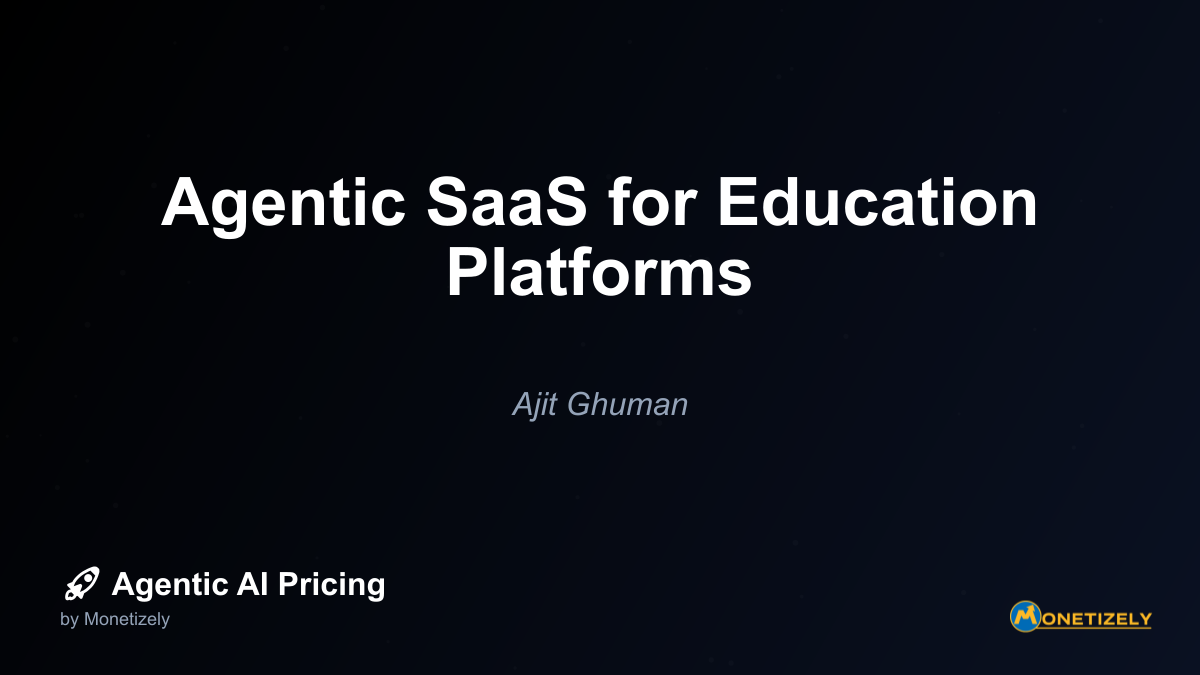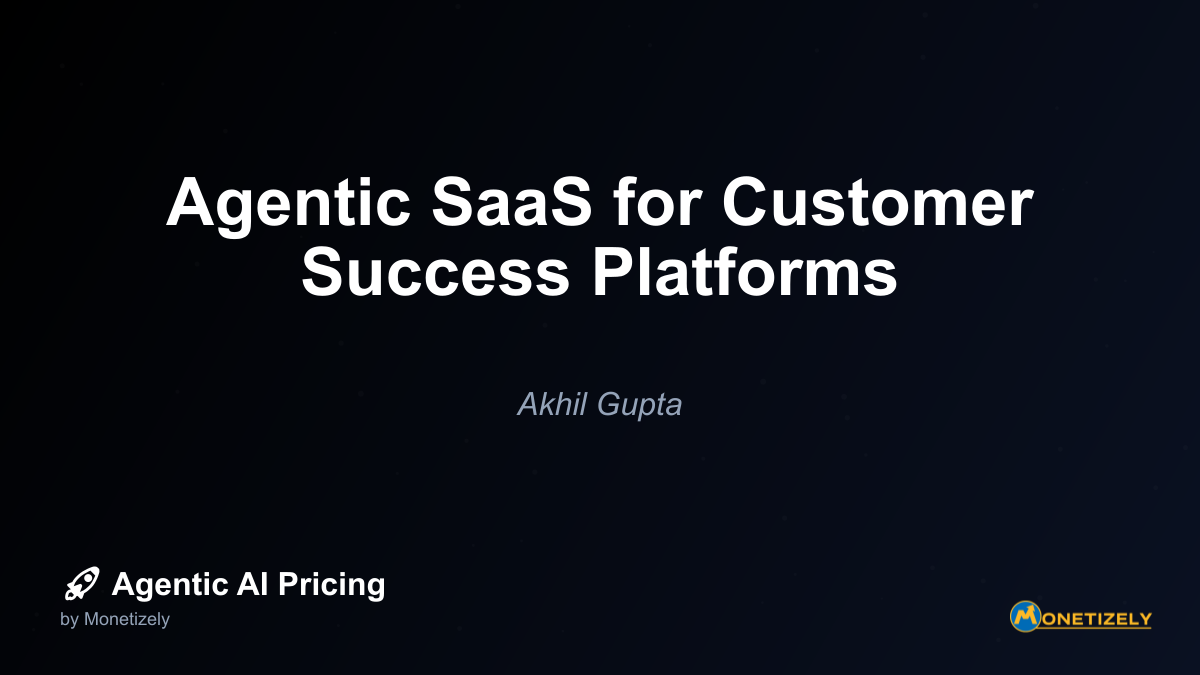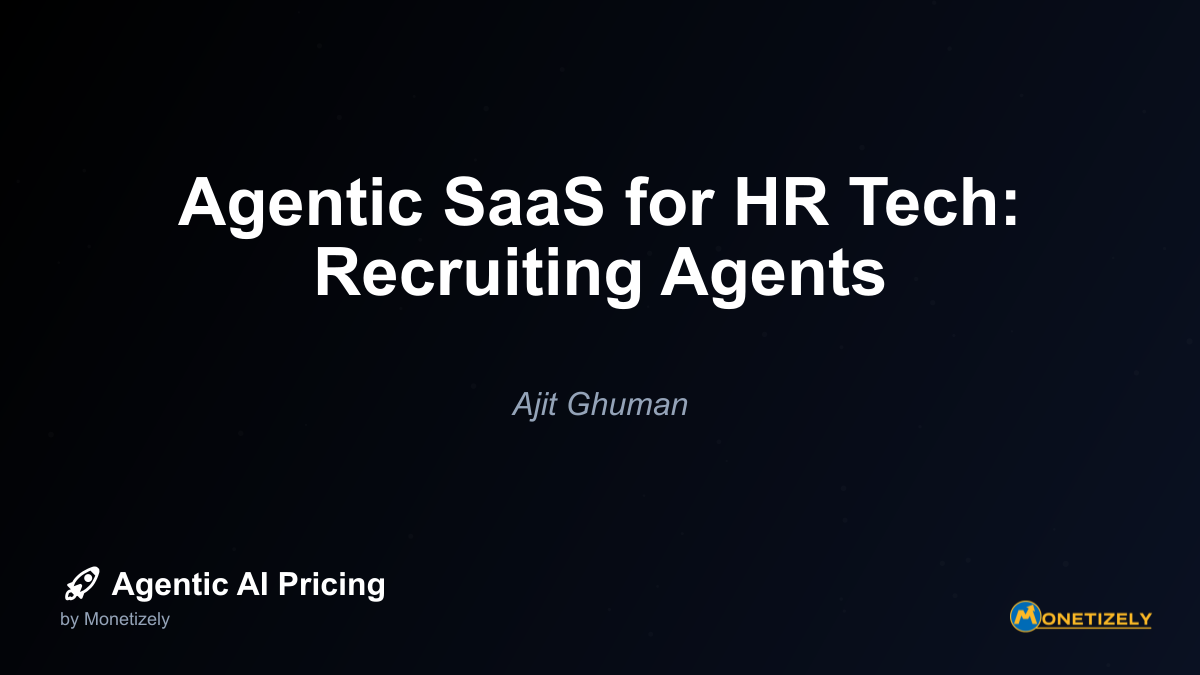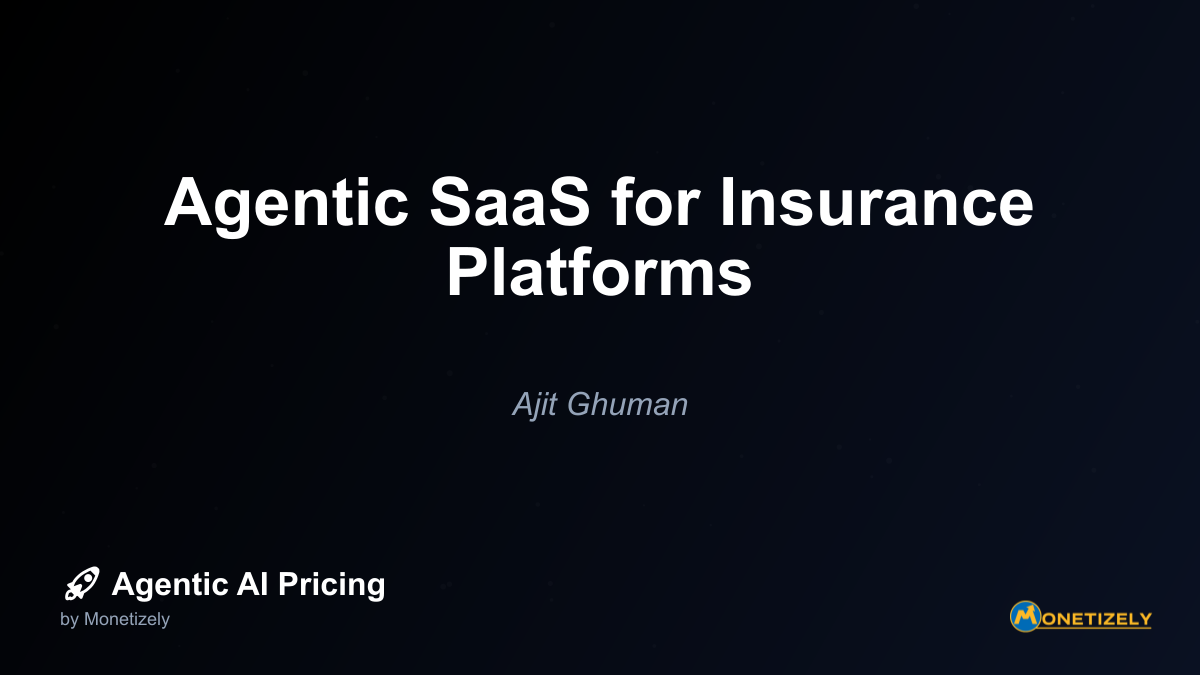· Akhil Gupta · Vertical Applications · 8 min read
Agentic SaaS in Consumer Apps
AI and SaaS Pricing Masterclass
Learn the art of strategic pricing directly from industry experts. Our comprehensive course provides frameworks and methodologies for optimizing your pricing strategy in the evolving AI landscape. Earn a professional certification that can be imported directly to your LinkedIn profile.

Innovative Pricing Models for Agentic Consumer SaaS
The personalized nature of agentic consumer applications demands equally personalized pricing strategies. Traditional subscription models often fail to accurately capture the value delivered through highly individualized experiences. Several innovative pricing approaches have emerged to address this challenge:
Value-Based Pricing
Agentic consumer applications can measure the concrete benefits they deliver to users, enabling truly value-based pricing models. For instance, a personal finance agent might charge based on a percentage of money saved or investment returns generated, while a productivity assistant could price based on documented time savings.
This approach aligns the application’s financial incentives with user outcomes, creating a more transparent value exchange. It also allows users to directly correlate their subscription costs with tangible benefits.
Personalized Subscription Tiers
Rather than offering standardized pricing tiers, agentic consumer SaaS can create dynamically personalized subscription packages based on individual usage patterns and preferences. The application might analyze which features provide the most value to a specific user and create custom feature bundles at optimized price points.
Real-time personalization in SaaS pricing allows for continuous adjustment of these offerings as user needs evolve, creating a more responsive relationship between value delivery and pricing.
Usage-Based Components
Many agentic consumer applications incorporate usage-based elements into their pricing structures. This approach recognizes that value delivery often correlates with frequency or depth of use. A health application might offer a base subscription with additional charges for specialized assessments or personalized coaching sessions.
Usage-based components are particularly effective for features that either:
- Require significant computational resources (like complex simulations or analyses)
- Deliver exceptional value beyond routine usage patterns
- Involve third-party services or data sources with variable costs
Outcome-Milestone Pricing
Some agentic consumer applications adopt milestone-based pricing, where users pay when they achieve specific outcomes or goals. A fitness application might offer free basic tracking but charge when users reach certain fitness milestones, while a language learning platform could charge upon demonstrated proficiency improvements.
This model creates powerful incentives for both users and developers. Users only pay when they receive concrete value, while developers are motivated to design effective interventions that help users succeed.
Freemium with Personalized Upsells
The freemium model remains effective for agentic consumer applications when combined with intelligent, personalized upselling. By analyzing individual usage patterns and needs, these applications can identify precisely which premium features would deliver the most value to specific users and present targeted upgrade opportunities at optimal moments.
This approach reduces friction in the initial adoption process while creating multiple opportunities to demonstrate value before requesting payment.
Privacy and Ethical Considerations
The deeply personalized nature of agentic consumer SaaS raises important privacy and ethical considerations that developers must address:
Data Collection Transparency
Users must understand what data is being collected, how it’s used to personalize their experience, and what control they have over the process. Transparent data policies build trust and reduce the perception of invasiveness.
Algorithmic Fairness
Personalization algorithms must be designed to avoid discriminatory outcomes or unfair treatment of certain user groups. Regular auditing for bias helps ensure equitable experiences across diverse populations.
User Control and Agency
Despite the autonomous nature of these applications, users should maintain ultimate control over key decisions and actions. The ability to override agent recommendations or adjust personalization parameters preserves user agency.
Data Security
The extensive personal data required for effective personalization creates heightened security responsibilities. Robust encryption, access controls, and data minimization practices are essential protections.
Ethical Pricing Practices
Personalized pricing must be implemented transparently to avoid perceptions of manipulation or discrimination. Users should understand the factors influencing their individual pricing and have opportunities to influence these determinations.
Implementation Challenges and Solutions
Developing and deploying agentic consumer SaaS presents several significant challenges:
Technical Complexity
Building truly effective agentic applications requires sophisticated AI capabilities, including natural language processing, machine learning, and decision-making algorithms. This complexity can extend development timelines and increase costs.
Solution: Many developers leverage pre-built AI services and frameworks rather than building capabilities from scratch. This approach accelerates development while maintaining customization options for unique use cases.
Data Requirements
Personalization quality directly correlates with data availability. New applications face the “cold start” problem of limited initial data for making accurate predictions or recommendations.
Solution: Progressive personalization approaches start with basic, rules-based personalization and gradually incorporate more sophisticated techniques as user data accumulates. Strategic use of third-party data (with appropriate permissions) can also accelerate the personalization timeline.
User Adoption Barriers
Users may be hesitant to trust autonomous agents with sensitive personal information or important decisions, particularly in early interactions.
Solution: Implementing gradual autonomy progression helps build trust. Applications can start with minimal autonomous actions and expand capabilities as users become comfortable with the system’s reliability and value.
Integration Complexity
Agentic consumer applications typically require integration with multiple external services and data sources to deliver comprehensive value.
Solution: API-first development approaches and robust middleware solutions help manage integration complexity. Many developers also prioritize partnerships with complementary services to create more seamless ecosystem experiences.
Resource Optimization
The computational requirements for real-time personalization and autonomous decision-making can strain system resources and impact performance.
Solution: Edge computing approaches, which process data closer to users, can reduce latency for time-sensitive operations. Batch processing for less urgent personalization tasks helps balance resource utilization.
Personalized pricing using AI represents another implementation challenge, requiring sophisticated algorithms that balance value delivery with user perception and business sustainability.
Future Trends in Agentic Consumer SaaS
Several emerging trends will shape the evolution of agentic consumer applications in coming years:
Multimodal Interaction
Future agentic consumer applications will move beyond text and voice to incorporate visual, gestural, and even biometric interaction modes. This expansion will make technology more accessible to diverse user populations and enable more natural human-computer interaction.
Collaborative Agency
Rather than operating in isolation, agentic applications will increasingly collaborate with each other to deliver more comprehensive solutions. A health application might coordinate with financial and productivity agents to create holistic wellness and life management solutions.
Predictive Personalization
Advanced predictive capabilities will enable applications to anticipate needs before users explicitly express them. This proactive approach will shift the paradigm from responsive to anticipatory assistance.
Emotional Intelligence
The integration of emotion recognition and response capabilities will create more empathetic agentic applications. These systems will adapt not just to explicit preferences but also to emotional states and implicit needs.
Decentralized Data Ownership
Blockchain and related technologies will enable new models of personal data ownership and monetization. Users may gain greater control over their data while still benefiting from personalization through secure, permission-based sharing mechanisms.
Augmented Reality Integration
The convergence of agentic applications with augmented reality will create immersive, context-aware experiences that blend digital assistance with physical environments. This integration will enable new categories of lifestyle applications that bridge virtual and physical contexts.
Case Studies: Successful Agentic Consumer SaaS
Several pioneering companies demonstrate the potential of agentic consumer SaaS:
Woebot Health
Woebot provides mental health support through an AI-powered conversational agent that applies cognitive-behavioral therapy techniques. The application adapts its approach based on user responses, emotional states, and progress patterns.
Key success factors include:
- Transparent explanation of therapeutic approaches
- Gradual building of therapeutic relationship
- Clear boundaries around capabilities and limitations
- Evidence-based intervention design
- Regular effectiveness assessment
Lensa AI
This photo editing application uses agentic capabilities to understand user aesthetic preferences and automatically enhance images according to individual tastes. The system learns from editing choices to create increasingly personalized results.
Notable aspects include:
- Progressive personalization that improves with usage
- Transparent explanation of AI-driven enhancements
- User control over final results
- Efficient processing that minimizes waiting time
- Clear privacy policies regarding image data
JoyRun
This fitness application combines workout tracking with autonomous coaching that adapts to individual capabilities, preferences, and progress. The system adjusts difficulty, provides personalized motivation, and creates custom training plans.
Distinctive features include:
- Multimodal interaction through voice and visual interfaces
- Context-aware workout recommendations based on location and conditions
- Adaptive difficulty based on performance and recovery metrics
- Social integration that respects individual privacy preferences
- Milestone-based pricing tied to fitness achievements
Conclusion
Agentic SaaS in consumer applications represents a transformative approach to personal technology that promises unprecedented levels of personalization and autonomy. By understanding individual contexts, learning from interactions, and taking independent actions, these intelligent applications are redefining the relationship between people and digital tools.
For developers and entrepreneurs in this space, success requires balancing technical sophistication with human-centered design principles. The most effective agentic consumer applications maintain transparency about their capabilities and limitations while delivering genuine value through personalization.
As these technologies continue to evolve, we can expect increasingly seamless integration of agentic capabilities into daily life, with autonomous agents handling routine tasks, providing personalized guidance, and enabling new forms of human productivity and wellbeing. The consumer application landscape is shifting from tools we use to assistants we collaborate with—a profound transformation that will reshape digital experiences across domains.
For business leaders and decision-makers, understanding this shift is critical to identifying new opportunities and adapting existing products for an increasingly agent-driven consumer technology landscape. Those who successfully harness agentic capabilities to deliver genuine personalization will define the next generation of consumer SaaS.
Co-Founder & COO
Akhil is an Engineering leader with over 16+ years of experience in building, managing and scaling web-scale, high throughput enterprise applications and teams. He has worked with and led technology teams at FabAlley, BuildSupply and Healthians. He is a graduate from Delhi College of Engineering and UC Berkeley certified CTO.
Pricing Strategy Audit
Let our experts analyze your current pricing strategy and identify opportunities for improvement. Our data-driven assessment will help you unlock untapped revenue potential and optimize your AI pricing approach.




